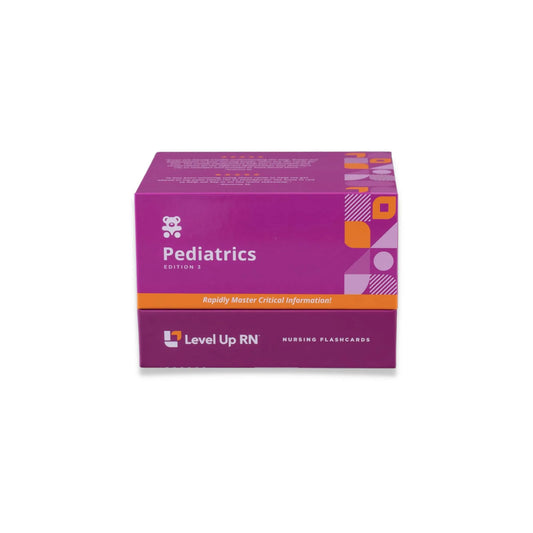- 0:00 What to Expect
- 0:23 Spina Bifida
- 0:35 Risk Factors
- 0:47 Occulta
- 1:08 Meningocele
- 1:23 Myelomeningocele
- 1:39 Diagnosis
- 1:58 Treatment
- 2:09 Nursing Care
- 2:39 Family Teaching
- 3:07 Cerebral Palsy
- 3:32 Signs and Symptoms
- 3:53 Treatment
- 4:21 Quiz Time!
- 5:23 Bloopers
Peds, part 37: Nervous Disorders - Spina Bifida, Cerebral Palsy
Full Transcript: Peds, part 37: Nervous Disorders - Spina Bifida, Cerebral Palsy
Full Transcript: Peds, part 37: Nervous Disorders - Spina Bifida, Cerebral Palsy
Hi, I'm Cathy with Level Up RN. In this video, we are going to talk about spina bifida and cerebral palsy. If you have our Level Up RN pediatric nursing flashcards, definitely pull those out so you can follow along with me. At the end of the video, I'm going to give you guys a little quiz to test your knowledge of some of the key facts I'll be covering in this video, so definitely stay tuned for that. Let's first talk about spina bifida, which is a neural tube defect that causes the baby's spinal cord not to develop properly in utero. And a key risk factor for this condition is insufficient folic acid intake during pregnancy. Other risk factors include maternal diabetes as well as maternal drug use.
So there are three types of spina bifida. First, we have spina bifida occulta. This is where we actually can't see the malformation in the spinal cord because skin is covering the area. However, we may see an abnormal tuft of hair or a dimple or a birthmark over the affected area. The second type of spina bifida is called meningocele. This is where we have a protrusion of a sac or a cyst over the baby's spinal cord that contains cerebral spinal fluid as well as meninges. And then lastly, we have myelomeningocele. This is where we have a protrusion of a sac or cyst over the spinal cord. And in that sac, we have cerebral spinal fluid, meninges, as well as part of the spinal cord.
Diagnosis of spina bifida can be done in the prenatal period using an ultrasound. Also, if during pregnancy blood work shows an elevation in AFP, then that is indicative of the possibility for a neural tube defect such as spina bifida. Treatment for spina bifida includes surgical closure of the defect as soon as possible. It can actually be done in utero if it is discovered during the prenatal period. In terms of nursing care, if the baby is born with a meningocele or myelomeningocele, we need to protect that protruding sac. So we're going to want to cover that sac with a sterile saline-moistened nonadherent dressing. And we want to avoid any kind of pressure to that sac. So we're going to place the baby in a prone position, so tummy side down, with their hips flexed. We also need to provide some important teaching to the family regarding complications that can occur with spina bifida, which includes hydrocephalus as well as latex allergies. The child will likely have an increased risk for pressure injuries as well as burns, which relates to their lack of sensation. And then bladder dysfunction is also common that often requires intermittent catheterization.
Next, I want to briefly talk about cerebral palsy, which is a neurological disorder that affects body movement and muscle coordination. So with this disorder, we have abnormal intrauterine development of the brain or some kind of hypoxic brain injury that damages the cerebral cortex and affects motor function. So signs and symptoms will include ataxia, so lack of coordination, as well as muscle spasticity and impaired gait. In severe cases, we can have intellectual disability and seizures as well as impaired swallowing, speech, vision, and hearing. In terms of treatment, we can actually use Botox or intrathecal baclofen to address the muscle spasticity associated with this condition. In addition, physical therapy and occupational therapy would be instrumental in terms of helping the child function to their maximum potential. In addition, speech therapy, assistive devices, and possible orthopedic surgeries may be used for the child.
All right. It's quiz time. Are you guys ready? I have three questions for you. The first question is a fill-in-the-blank question. Insufficient intake of blank during pregnancy increases the risk for spina bifida. The answer is folic acid. Question number two, an infant with a meningocele should be placed in what position? The answer is prone with their hips flexed. Question number three, what type of spina bifida is characterized by the protrusion of a cyst with meninges, cerebral spinal fluid, and a portion of the spinal cord? The answer is myelomeningocele. All right. I hope you did well on that quiz, and I hope this video was helpful. If so, be sure to give me a thumbs up and leave me a comment. Take care, and I'll see you soon.
There are three types of spina bifida. The first is spina bifida occulta. This is where the defect actually can't be seen in the spinal cord because there is skin covering that area. However, we may see a [inaudible].



2 comments
Good
Good